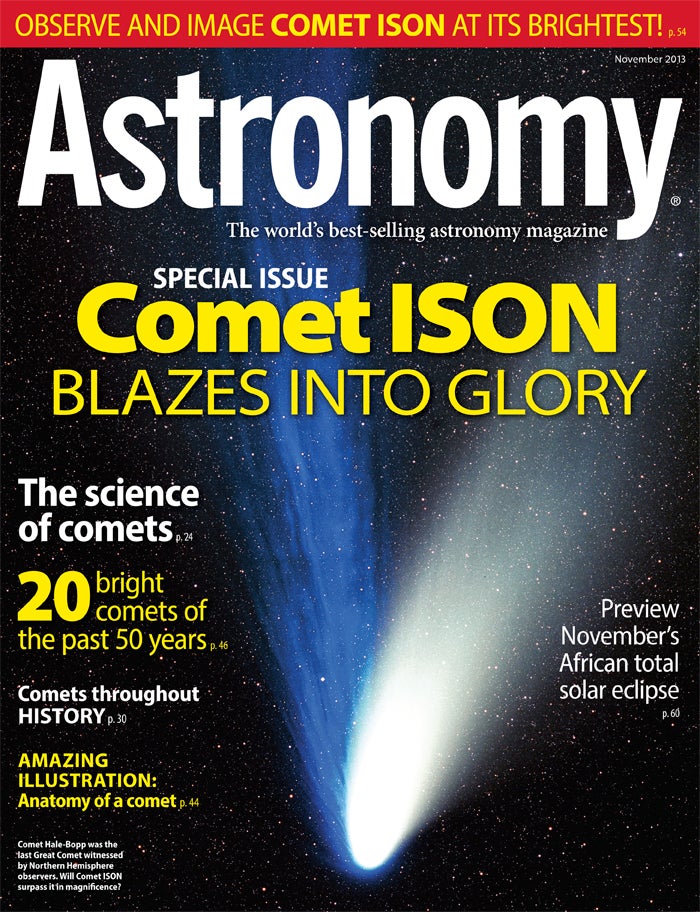
Waukesha, Wis. – Because 2013 has been deemed the “Year of the Comet,” Astronomy magazine decided to dedicate a full issue these visitors from the outer solar system. The November issue contains stories that describe the science, history, and anatomy of these dirty snowballs, in addition to observing tips to view Comet ISON (C/2012 S1), the object that’s destined to become a brilliant sky target by mid-month.
Read more about these icy interlopers and specifically Comet ISON in the November 2013 issue of Astronomy magazine, on newsstands October 1.
“The science of comets”
Planetary scientist Matthew Knight describes what comets are, where they originate, and how researchers know this information in “The science of comets.” He covers the nine spacecraft, encompassing 11 missions, that have visited the dusty snowballs and how those investigations have helped scientists understand the inner solar system interlopers. “We continue to research comets to answer the mystery of how life got to Earth and to learn valuable clues about how the solar system formed and evolved,” writes Knight. “And if comets happen to put on a show while teaching us more about our place in the cosmos, then that’s just icing on the cake.”
“Comet ISON blazes into glory”
Will Comet ISON (C/2012 S1) be the comet of the century? We’ll find out soon, as estimates have the object visible through binoculars in early November. According to International Astronomical Union predictions, Comet ISON will peak a magnitude –4.5, equivalent to Venus’ brightness, as it skims just 730,000 miles (1.16 million kilometers) from the Sun’s surface November 28 – that’s Thanksgiving Day in the United States. For more about how to observe the comet and what scientists are predicting about its appearance, see Senior Editor Richard Talcott’s “Comet ISON blazes into glory.”
“Anatomy of a comet”
When a comet’s icy and dusty nucleus nears the Sun, our star’s heat turns the ice to gas, creating a fuzzy coma around the nucleus; a dust tail and an ion one also form from the material. In “Anatomy of a comet,” a two-page super-illustration, Associate Editor Sarah Scoles and Illustrator Roen Kelly take you inside a comet’s composition and nearby environmental factors.
“Comets: From superstition to science”
Thousands of years ago until just recently, the sudden appearance of a comet in the sky brought fears of death and destruction. Gary Kronk tracks cometary study from its astrological roots to its current state of scientific importance in “Comets: From superstition to science.”
You might be surprised to hear how long it took researchers to understand what comets really are and that they aren’t harbingers of death.
November night-sky events visible without optical aid
- November 2 – The Moon passes 8° north of Spica (Alpha [] Virginis).
- November 3 – A total solar eclipse occurs along a narrow path that cuts across the Atlantic Ocean and equatorial Africa.
- November 6 – The Moon passes 8° north of Venus.
- November 17 – The Leonid meteor show peaks.
- November 28 – Comet ISON (C/2012 S1) skims just 730,000 miles (1.16 million kilometers) from the Sun’s surface at 2 p.m. EST.
Also in the November 2013 Astronomy
- “20 bright comets of the past 50 years” – Each of these cosmic visitors of the past half-century told a unique story and captured the attentions of observers and imagers.
- “Totality crosses Africa” – Exotic locations, safaris, and an eclipse’s shadow across the Dark Continent will lure travelers to this event November 3.
- “A field trip to the stratosphere” – Associate Editor Sarah Scoles takes a ride with SOFIA, a telescope that always flies first class.
- “The Sky this Month” – Exclusive star charts will guide you through November’s night sky.
- The November issue of Astronomy also includes Astro News, Ask Astro, Snapshot, Breakthrough, Bob Berman’s Strange Universe, Stephen James O’Meara’s Secret Sky, Glenn Chaple’s Observing Basics, Cosmic World, Letters, Web Talk, New Products, Reader Gallery, and Final Frontier.









